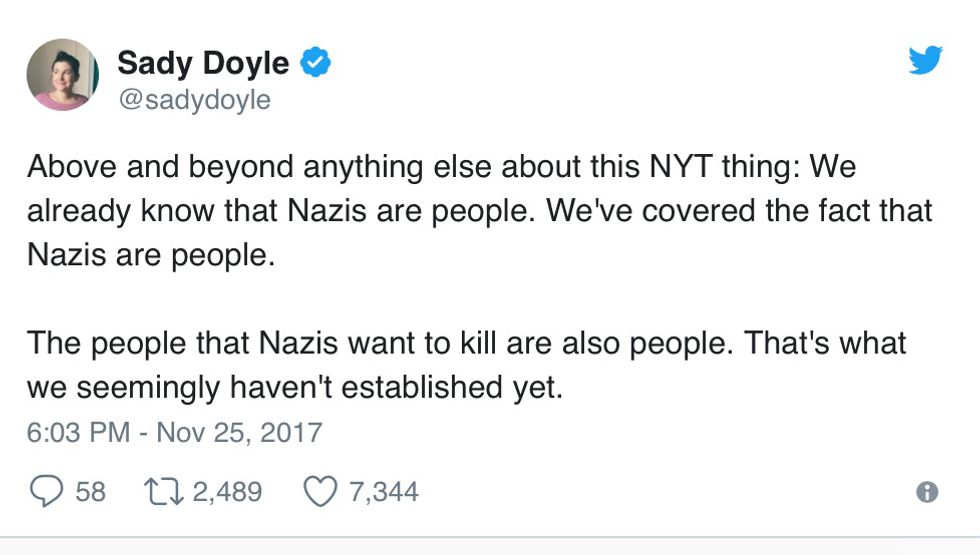Criticizing the New York Times has become something of a national sport in recent years—whether it's over the ludicrous suggestion that green peas have a place in guacamole, a tone-deaf description of the Taiwanese treat bubble tea, or some hand-wringing about the unfortunate fathers forced to parent when their wives attended protest marches.
The US paper of record triggered another wave of internet outrage today (and at least one great satire) when it published a cheerful profile of Tony Hovater, a self-described "white nationalist" who argues that Adolf Hitler was a guy who "really believed he was fighting for his people and doing what he thought was right."
The article describes Hovater, a 29-year-old welder from Ohio, as "the Nazi sympathizer next door, polite and low-key at a time the old boundaries of accepted political activity can seem alarmingly in flux." It is clearly meant to be a glimpse behind the curtain, a snapshot of an openly racist man whose views have edged closer to the mainstream in an era where white supremacists march triumphantly and the commander-in-chief defends them as including "some very fine people."
Many have pointed out that the Times article normalizes these racist views, juxtaposing Hovater's co-founding of an extremist party that marched in August's white supremacist rally in Charlottesville, Virginia, with the young man's love of the sitcom Seinfeld and his "fondness for National Public Radio"; his four cats, and the muffin pan and pineapple slicer on the registry for his upcoming wedding.
What's problematic about the story, ultimately, is not that it humanizes a man with repugnant views—he is, of course, a human. It's the lack of any explanation to the reader of why exactly this story exists, and what the writer expects the reader to glean from it. Without that we have, essentially, a puff piece about a Nazi sympathizer.
The New York Times writer himself, Richard Fausset, seems to acknowledge this absence in a behind-the-scenes piece he wrote as a companion to the profile. The question he set out to answer, he says, was how Horvater morphed "from vaguely leftist rock musician to ardent libertarian to fascist activist."
"Where was his Rosebud?" Fausset asks, going on to admit his failure to answer that question:
After I had filed an early version of the article, an editor at The Times told me he felt like the question had not been sufficiently addressed. So I went back to Mr. Hovater in search of answers. I still don't think I really found them. I could feel the failure even as Mr. Hovater and I spoke on the phone, adding to what had already been hours of face-to-face conversation in and around his hometown New Carlisle, Ohio.
It is undoubtedly a difficult question to answer. But a non-answer does not make for an authoritative article—not in the US paper of record, on one of the most pressing issues of our time. (I have reached out to the Times for comment on the article, and will update this post with any response.)
The Times remains a bastion of fine journalism—it recently broke openthe scandal of Harvey Weinstein's alleged sexual assaults, after all, and has not flinched from coverage of the administration of US president Donald Trump, despite his threats and heckling.
But these are dangerous times, and we must hold our best journalists to high standards. This article failed to meet those standards.
Many others felt similarly:
By Indrani Sen on Quartz, November 25, 2017
###
November 26, 2017





